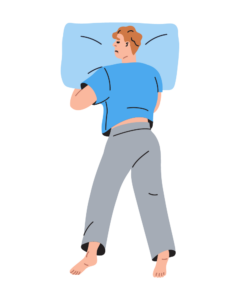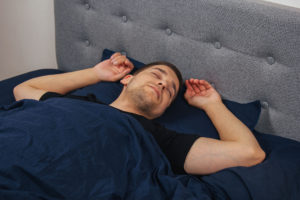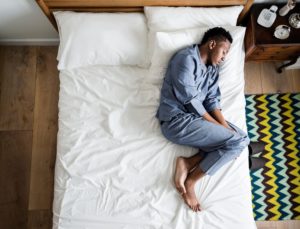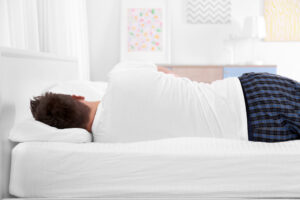When you buy through our links, we may earn a commission. Products or services may be offered by an affiliated entity. Learn more.
Best Sleeping Positions
- The ideal sleeping position promotes healthy spine alignment from your head to your hips.
- The best position depends on your unique needs, but back or side sleeping is considered better than stomach sleeping.
- Side sleeping may reduce snoring and heartburn and prevent back pain.
- Sleeping on your back is best for neck pain and nasal congestion.
During sleep, your body works to restore and repair itself. Your sleep position can either help or hinder that process, depending on how effectively it supports the natural curvature of your spine. It’s also common for people to wake up with brand new aches and pains in the morning, sometimes due to sleep position.
We spend a third of our lives asleep or resting, so it’s important to choose a sleep position that assists your body with physical recovery. A proper sleep position can relieve stress on your spine, while an unhealthy position can increase pain or stiffness in the back, arms, or shoulders, all while contributing to lower-quality sleep.
What Is the Best Sleeping Position?
The best sleep position is one that promotes healthy spinal alignment from your hips all the way to your head. What that looks like for you depends on your personal health situation and what you find comfortable.
Having said that, there are some positions that are considered healthier than others. Specifically, sleeping on the side or back is considered more beneficial than sleeping on the stomach. In either of these sleep positions, it’s easier to keep your spine supported and balanced, which relieves pressure on the spine and enables your muscles to relax and recover.
Different sleep positions provide different benefits that may be helpful for you if you’re dealing with back pain or a health condition. In these cases, it may be worth trying a new sleep position to enable more restful sleep. In one study, a group of adults with back pain were trained to sleep on their back or their side. They experienced significant pain relief in just four weeks.
Adjusting to a new sleep position takes time. However, if sleeping on your stomach feels good to you, don’t feel forced to change it. You can minimize your risk of pain and improve spinal alignment with the right mattress and pillow.
Is Your Troubled Sleep a Health Risk?
A variety of issues can cause problems sleeping. Answer three questions to understand if it’s a concern you should worry about.
Sleeping on Your Side
More than 60% of people sleep on their side, with men spending more time on their sides each night than women. As children, we split our nights by sleeping in all positions equally, but by adulthood, a clear preference for side sleeping emerges. The flexibility of our spine decreases as we age, which may make the side sleeping position more comfortable for older adults.

Sleeping on your side offers several benefits. It promotes healthy spinal alignment and is the sleep position least likely to result in back pain, especially when supported with pillows. Side sleeping also may reduce heartburn and snoring , making it particularly beneficial for:
- Pregnant women
- People with acid reflux
- People with back pain
- People who snore or have sleep apnea
- Older people
Best Sleeping Position for Pregnancy
Experts recommend that those who are pregnant sleep on their side with the knees bent . The side sleeping position relieves the pressure of a growing belly, enabling the heart to pump and blood to flow easily throughout the body. In particular, the left side is recommended because it prevents pressure on the liver and facilitates healthy blood flow to the fetus, uterus, kidneys, and heart.
If you feel discomfort sleeping on your left side during pregnancy, you can switch to the right side now and then to relieve pressure on the left hip. You can also relieve tension by placing pillows under the belly, between the legs, and at the small of the back.
Best Sleeping Position for Back Pain
The best sleeping position for is on your side with a pillow or blanket between the knees. Side sleeping can also relieve symptoms for those with neck or back pain.
Choose a pillow with a loft, or thickness, that matches the distance between your neck and your shoulder. With a thicker pillow, your neck will stay aligned with your spine as you sleep on your side, preventing pain and soreness while maintaining proper alignment.
Are There Any Drawbacks To Sleeping on Your Side?
The side sleeping position is not recommended for people with shoulder pain or people worried about wrinkles.
Side sleeping can lead to soreness or tightness in your shoulders , so it’s good to shift positions occasionally and use the most appropriate pillow and mattress. Ensure your mattress has enough “give” to allow your hips and shoulders to sink in deeper than your middle spine.
Side sleeping can also contribute to facial wrinkles , since your face is pressed against the pillow, stretching and compressing the skin.
Is One Side Better Than the Other?
If you’re already a side sleeper and want to go for that gold star, opt to sleep on your left instead of your right side. Sleeping on the right may increase pressure on your internal organs, which is why experts recommend the left for pregnant women and sleepers with acid reflux or gastroesophageal reflux disease (GERD). Sleeping on the right can also intensify symptoms of heartburn.
Sleeping in a way that’s less symmetrical can increase your risk of pain symptoms upon waking up, so use pillows to achieve a side sleeping position that aligns your spine from hips to your head. Put pillows on either side of your body to keep yourself in place, and place a small pillow between the knees to even out the hips.

Sleeping on Your Back
Lying on the back is the second most popular sleep position, with plenty of benefits to rival the side sleeping position. When you’re flat on your back, it’s easy to keep your spine in alignment and to evenly distribute your body weight, preventing any potential aches in the neck or back. Sleeping on the back can also relieve the congestion of a stuffy nose or allergies, so long as you prop yourself up into an upright position.

Your skin also benefits from the back sleeping position. Since you’re facing upward, there is no pillow or mattress pressing against your face and contributing to wrinkles. Back sleeping may be particularly beneficial for:
- People with lumbar spinal pain
- People worried about wrinkles
- People with neck pain
- People with nasal congestion
Best Sleeping Position for Neck Pain
Lying on the back is the best sleep position for neck pain, as it prevents the misalignment that can occur in the side or stomach positions. To prevent neck pain, use a pillow that supports the neck while letting your head sink deeper. Memory foam pillows or pillows with a divot for the head are good options. Alternately, you can roll a towel underneath your neck and use a flatter pillow for your head.
When sleeping on your back, aim to keep your arms in similar positions. For example, having them both lie by your sides is preferable to having one rested on your forehead, as that causes unevenness in the spine that can contribute to shoulder or neck pain.
Best Sleeping Position for Stuffy Nose
If you’re coping with allergies or a stuffy nose, use pillows to prop up your upper back so you’re in more of an upright position, without collapsing the spine. This positioning can enable your airways to stay open and may help drain your nose. Avoid lying flat on your back, as that may increase nasal congestion .
Are There Any Drawbacks To Sleeping on Your Back?
The back sleeping position is not recommended for:
- Pregnant women
- People who snore or have sleep apnea
- People with some types of back pain
- People with GERD or acid reflux
- Heavier adults
- Older adults
Back sleeping is the worst sleeping position for people with snoring and sleep apnea because it leaves you susceptible to airway collapse. More than half of people have position-dependent sleep apnea, meaning that the severity of their symptoms increases when they lie on their back. Especially as we grow older or heavier, it becomes harder to breathe while lying on our backs, due to the pressure of gravity on the body.
Also, while some people feel relief from the back sleeping position, others find it increases their back pain. Depending on the firmness of your mattress, a small gap can form between your lower back and the mattress surface, which can lead to uncomfortable tension in the lower back. You can resolve this by placing a thin pillow in that area, or placing a pillow under your knees instead. Either way, you’ll relieve pressure while supporting the natural curvature of your spine. You can also switch between back and side sleeping throughout the night.
The back sleeping position is not recommended for pregnant women because a growing baby can add pressure on the heart and make it difficult for blood to flow easily. Theoretical postulation may suggest that sleeping on the back during the third trimester can increase the risk of stillbirth, though conclusive evidence is lacking.
Sleeping on Your Stomach

The stomach is the least popular sleep position. Research suggests we spend less than 10% of our night sleeping in this position. Stomach sleeping does have some benefits, however. Namely, the stomach sleeping position can help relieve snoring, by opening up your airway. However, your ribs do have to work against gravity in order to breathe in this position, which may force you to use more energy and thereby make your sleep less restful.
What’s Wrong With Stomach Sleeping?
The stomach sleeping position comes with several drawbacks and is not recommended for most people. In particular, the following people should avoid sleeping on their stomachs:
- Pregnant women
- People with neck or back pain
- People worried about wrinkles
The stomach position provides the least back support of all sleeping positions and increases pressure on the spine, sometimes causing pain upon waking up. In order to sleep on your stomach, you must sleep with your head facing one side, invariably twisting your neck and head out of alignment with the rest of your spine. If your mattress isn’t firm enough, your stomach and hips will sink into the mattress, uncomfortably stretching your spine out of alignment. This kind of asymmetrical sleep posture can negatively impact your spine over time. Also, sleeping on the stomach can contribute to facial wrinkles, since your face is pressed against the pillow or the surface of the mattress.
How to Sleep Better on Your Stomach
Without the right pillow and mattress, it’s easy for the stomach sleeping position to cause aches and pains. However, it is possible to sleep well in this position. If you enjoy sleeping on your stomach, try doing so with a very thin pillow, or no pillow at all. This way, you can avoid tilting your neck back and up, creating further spinal misalignment and discomfort. Place a thin pillow under your hips to further even out the spine and relieve pressure. A firm mattress can also prevent some of the spinal alignment issues that come from sleeping on your stomach.
The best sleep position for you is whichever sleep position enables you to enjoy a restful night of uninterrupted sleep and wake up in the morning feeling refreshed, without any aches and pains. If that describes your current sleep position, don’t feel forced to change it. If you think a new position might make sleep more comfortable for you, though, go ahead and try another position. Be patient and use the strategies named to help yourself adjust to the new position.
Your sleep position plays a pivotal role in the quality of your sleep. Changing it up is just one of many strategies you can try for better sleep.

Still have questions? Ask our community!
Join our Sleep Care Community — a trusted hub of sleep health professionals, product specialists, and people just like you. Whether you need expert sleep advice for your insomnia or you’re searching for the perfect mattress, we’ve got you covered. Get personalized guidance from the experts who know sleep best.
References
10 Sources
-
Cary, D., Briffa, K., & McKenna, L. (2019). Identifying relationships between sleep posture and non-specific spinal symptoms in adults: A scoping review. BMJ Open, 9(6), e027633.
https://pubmed.ncbi.nlm.nih.gov/31256029/ -
Skarpsno, E. S., Mork, P. J., Nilsen, T., & Holtermann, A. (2017). Sleep positions and nocturnal body movements based on free-living accelerometer recordings: Association with demographics, lifestyle, and insomnia symptoms. Nature and Science of Sleep, 9, 267–275.
https://pubmed.ncbi.nlm.nih.gov/29138608/ -
Khoury, R. M., Camacho-Lobato, L., Katz, P. O., Mohiuddin, M. A., & Castell, D. O. (1999). Influence of spontaneous sleep positions on nighttime recumbent reflux in patients with gastroesophageal reflux disease. The American journal of gastroenterology, 94(8), 2069–2073.
https://pubmed.ncbi.nlm.nih.gov/10445529/ -
Ravesloot, M. J., van Maanen, J. P., Dun, L., & de Vries, N. (2013). The undervalued potential of positional therapy in position-dependent snoring and obstructive sleep apnea: A review of the literature. Sleep & breathing, 17(1), 39–49.
https://pubmed.ncbi.nlm.nih.gov/22441662/ -
A.D.A.M. Medical Encyclopedia. (2020, June 2). Problems sleeping during pregnancy. MedlinePlus.
https://medlineplus.gov/ency/patientinstructions/000559.htm -
Zenian, J. (2010). Sleep position and shoulder pain. Medical Hypotheses, 74(4), 639–643.
https://pubmed.ncbi.nlm.nih.gov/20036076/ -
Anson, G., Kane, M. A. C., & Lambros, V. (2016). Sleep wrinkles: Facial aging and facial distortion during sleep. Aesthetic Surgery Journal, 36(8), 931–940.
https://pubmed.ncbi.nlm.nih.gov/27329660/ -
Lee, W. H., & Ko, M. S. (2017). Effect of sleep posture on neck muscle activity. Journal of Physical Therapy Science, 29(6), 1021–1024.
https://pubmed.ncbi.nlm.nih.gov/28626314/ -
Berson, S. R., Klimczak, J., Prezio, E. A., Hu, S., & Abraham, M. (2018). Clinical associations between allergies and rapid eye movement sleep disturbances. International Forum of Allergy & Rhinology, 8(7), 817–824.
https://pubmed.ncbi.nlm.nih.gov/29461689/ -
O’Brien, L. M., & Warland, J. (2014). Typical sleep positions in pregnant women. Early Human Development, 90(6), 315–317.
https://pubmed.ncbi.nlm.nih.gov/24661447/
















